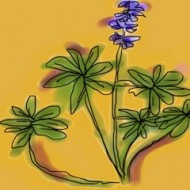The Dry Garden: Landmark book for California
Until now, there was always one sure way to tell whether or not you had hired the right landscape designer or architect for a job in California. The right one had a copy of Bob Perry’s 1992 book “Landscape Plants for Western Regions,” which was used so often that it occupied the passenger seat of his or her truck. That criterion changed this week. After eighteen years, Perry has finally produced a successor volume: “Landscape Plants for California Gardens.” For those of you worried about how to comply with the water budgets prescribed in last year’s Assembly Bill 1881, Perry gives the evapotranspiration rates not just for thousands of plants, but also correlates them for every California climate zone. He looks at water efficiency of irrigation systems. And, the reason landscapers loved him, after grouping plants by palette, he conclusively links those palette groups back to their water budgets.
“Landscape …
The Dry Garden: Meet the natives
It’s only February, but bestirred by rain and gathering days, California lilacs are blooming, manzanitas are bedecked with bells and irises are pent up for a March explosion. It doesn’t just feel like spring, it is spring in Southern California. So, if you are considering a dry garden for your home, now is the time to meet the natives. This is the moment to go to Rancho Santa Ana Botanic Garden in Claremont. Click here to keep reading The Dry Garden in the Los Angeles Times.
For listings of courses, hikes, plant sales and projects for Southern Californian dry gardeners, click here for a February calendar, and here for a March one.
…
The Dry Garden: Grand illusion
In his 1982 autobiography “My Last Breath,” film director Luis Buñuel wrote:
A year can go by, even two, without so much as a single cloud in the impassive sky. Whenever an adventuresome cumulus wandered into view just above the mountain peaks, all the clerks in the grocery next door would rush to our house and clamber up onto the roof. There, from the vantage point of a small gable, they’d spend hours watching the creeping cloud, shaking their heads and murmuring sadly: “Wind’s from the south. It’ll never get here.”
And they were always right.
May a Los Angeles filmmaker one day match the elegance with which the Spanish-born Buñuel exaggerated the dryness of his native Aragon. Annual rainfall there is much like ours: 12 to 15 inches a year.
But when it comes to exaggeration here, our tendency is to overstate the rain. Ever notice how much it …
The Dry Garden: In praise of Leo Politi
A rant in the current Atlantic magazine argues that a plague of school gardens – thousands! – is returning the children of California’s Latino immigrants to the kind of stoop labor that their families struggled to escape. “Cultivating Failure” tilts at the groupies of celebrity chef Alice Waters and her Edible Schoolyard program in such an entertaining way that it’s a pity that so little of the article is true.
Click here to keep reading this week’s The Dry Garden in the Los Angeles Times.…
The Dry Garden: Native mallows
Few plants better connote the sheer luxuriance of the California dream as hibiscus. It comes from a clan of plants known as mallows native to the tropics, where, University of Texas botanist Paul A. Fryxell says, this family finds its “greatest richness.”
Fryxell is an authority on mallows, a family that he says has more than 100 genera with cousins around the world, capable of tolerating situations as diverse as the high climes of the Andes, hot and dry Palm Desert and the mediterranean climate of coastal California.
Talk to Fryxell and it soon becomes clear why hibiscuses in Southern California needn’t be a guilty pleasure, even though they’re tropical. Thanks to their robust root systems, many can go with only occasional deep watering during dry season. Once established, they are happiest when treated like trees.
For Californians, he also points to our native mallows. Those who haven’t expanded from …
« go back — keep looking »

